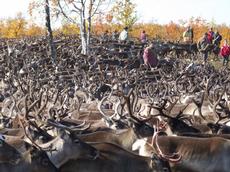Paying for predators instead of damages
In the canton of Valais, a wolf was shot which had caused “intolerable” damage to farm animals. ETH researcher Astrid Zabel explains how other countries attempt to defuse the conflict between domestic and wild animals.

Ms.
Zabel, last week in Valais the shooting of a wolf was approved and then
immediately carried out. What do you think of that?
I would not like to comment on that: I am a scientist and try to remain neutral
– I would not like to take one side or the other, so that my research is not
coloured by this.
Every
year in Switzerland, the
conflict flares up with the summer pasturing of farm animals on the Alps, and as a rule it has a fatal outcome for the predators.
Does it have to be like this, or can you recommend an alternative approach on
the basis of your research?
It is clear that predators are gaining ground not only in Switzerland,
and that the question will remain current for a long time. The media always pay
a great deal of attention when a decision of this kind is made. In my research,
it was a question of finding out how concrete, politically determined
objectives for the protection of predators can be achieved through policy
measures. My work relates to the situation of predators in Sweden and that of the tiger in India. But it
is not my role to discuss these objectives. Rather, it is to research how the
system can be designed as sustainably as possible and optimally for all
stakeholders.
But
one must then first of all reach a consensus on how many predators are
acceptable for everyone. Is there a great deal of haggling about it?
In Sweden
the government first of all commissioned a study in order to find out how many
individuals are needed in order to ensure a healthy, sustainable predator population
that can survive. Through international treaties, Sweden too has undertaken to
protect these animals. However, the situation there is such that there is much
more space for predators than there is in Switzerland; there are enormous
forests and unpopulated areas.
But
the reindeer herders also let their animals graze freely, and they can become
easy prey just as sheep can in the Swiss Alps.
In winter, reindeer really are easy prey for predators. Predators are and have
always been dependent on reindeer as a food source. So it is also clear that
the fewer predators there are, the better the reindeer survive.
What
could Switzerland learn from
Sweden
about protecting predators?
That’s hard to say. Sweden
is organised quite differently. I do not know whether this system would be of
any benefit for predators in Switzerland.
How
does the Swedish system work?
In Sweden, the reindeer
herders are organised into 51 Sami villages, which administer corresponding
grazing areas and thus cover two thirds of the whole country. In these
villages, the herders have grazing rights but not ownership rights. They are
allowed to let the animals graze unsupervised. However, the number of predators
is recorded annually, and depending on the rejuvenation of the predator
population in their area, the villages receive certain payments. For a litter
of wolves, there would be a payment of 500,000 Swedish kroner, which are
roughly 71,350 Swiss francs. However, this sum has never been paid out, because
at present there are no wolves in the Swedish reindeer areas. There are wolves
only in the south, and these have no contact with other populations. Occasionally
wolves enter northern Sweden,
but they are mostly shot, unless they are animals from the east, in which case
attempts are made to let them migrate as far as southern Sweden, in order to revitalise the blood of the
animals there. But this does not happen very often. If predators such as the
lynx, wolverine or wolf occur in reindeer areas, their presence alone triggers
payments to the villages.
Is
that a flat rate payment for damages so that state expenditure is kept as low
as possible?
Until 1996, the state compensated the herders for reindeer that were taken, and
paid their market value. The herders then had to go and look for the dead
reindeer. But that did not work well, because in spite of everything no-one had
any incentive to let the predators live. After that, the state turned the
tables and now it pays for the predators that are there. Now no-one has to go
searching for dead reindeer. That is a concession to the herders. The flat rate
is set so that it corresponds roughly to the damage that a predator causes in
its lifetime.
What
happens to the money?
The Sami villages are free to do as they wish with the money. The state leaves
the decision to the villages. It has been shown that it is most beneficial for
the protection of predators if a village distributes the money to individual
reindeer herders. As a rule, smaller villages protected their predators better
than large ones. There is however also a second effect associated with group
size. Large villages tended more to distribute the money to individual group
members, which also has a positive effect on the protection of predators.
Why
do the larger villages have a greater tendency to distribute the money to
individuals?
Because in large groups, it is more difficult to achieve a consensus on how the
money is to be spent collectively. One would have to achieve agreement with
more people.
You
have also studied the problem of tigers in India.
What are the problems like there?
It is significant that many threatened species of predators live in the
tropics. The question was therefore whether the approach used in Sweden can also be transferred to a tropical
country. In India this has
turned out to be very difficult. The tigers live in parks, and there are many
villages surrounding them. In Sweden,
by contrast, there can be several predators in a village, so that allocation to
a village is easier. In India, we do not have this connection between
individual villages and “their” tigers.
So
what approach is taken there?
Various studies show that tiger populations depend on the quantity of their prey,
and this in turn is affected by the grasses and foliage available. In the parks,
everything is still green, but all round them everything has been stripped bare
by the farm animals. For this reason, the idea came up of compensating the
inhabitants for reducing over-grazing. That is an indirect chain. Generally,
there has been interest in the approach, but it is not yet feasible in practice.
One would have to work together with an environmental organisation like the
WWF.
Is
money the best key to protecting predators?
One problem is that the issue also has an emotional side. Reindeer herders or
shepherds are usually met with a pitying smile for worrying so much about their
animals. We were therefore asked to extend the study to the stress which the
herders suffer because of the predators. We recorded stress symptoms and calculated
correlations between the symptoms and predator density, reindeer losses and the
number of working hours spent with the animals.
What
did that show?
Stress symptoms are much more strongly correlated with actual losses than with
predator density. Interestingly, in Sweden
there is a low correlation between predator density and average reindeer losses.
It is important to include the emotional component and to take it seriously. For
in monetary terms, sheep for example are not worth very much, and they can
easily be replaced, but the emotional stress is difficult to compensate.
Does
it make any difference whether someone has animals as a hobby or makes a living
from them?
Not all reindeer herders in Sweden are full-time herders. Our study showed that
the stress is considerably greater in people who are economically dependent on
their animals.
What
prompted you to carry out this study?
I was an exchange school student in Sweden and the life of the Sami fascinated
me. At university I became enthusiastic about resources management. When I was
looking for a topic for my dissertation, I came across the Swedish system. At
the ETH, I then had the opportunity to get to the bottom of questions about the
Swedish system and its transferability to India. The project was supported by
the North-South Centre and FORMAS in Sweden.
Astrid Zabel is a doctoral student in the group of environmental policy and environmental economy at the Institute of Environmental Decisions. The 30-year-old German studied in Bonn and Gödöllö, Hungary, and graduated in 2006 in Agricultural and Resources Management. Her dissertation at ETH Zurich, which she completed in early 2010, concerns policy instruments that can be used to ameliorate conflicts between economically useful animals and predators, in particular how they can be used in developing countries.








READER COMMENTS